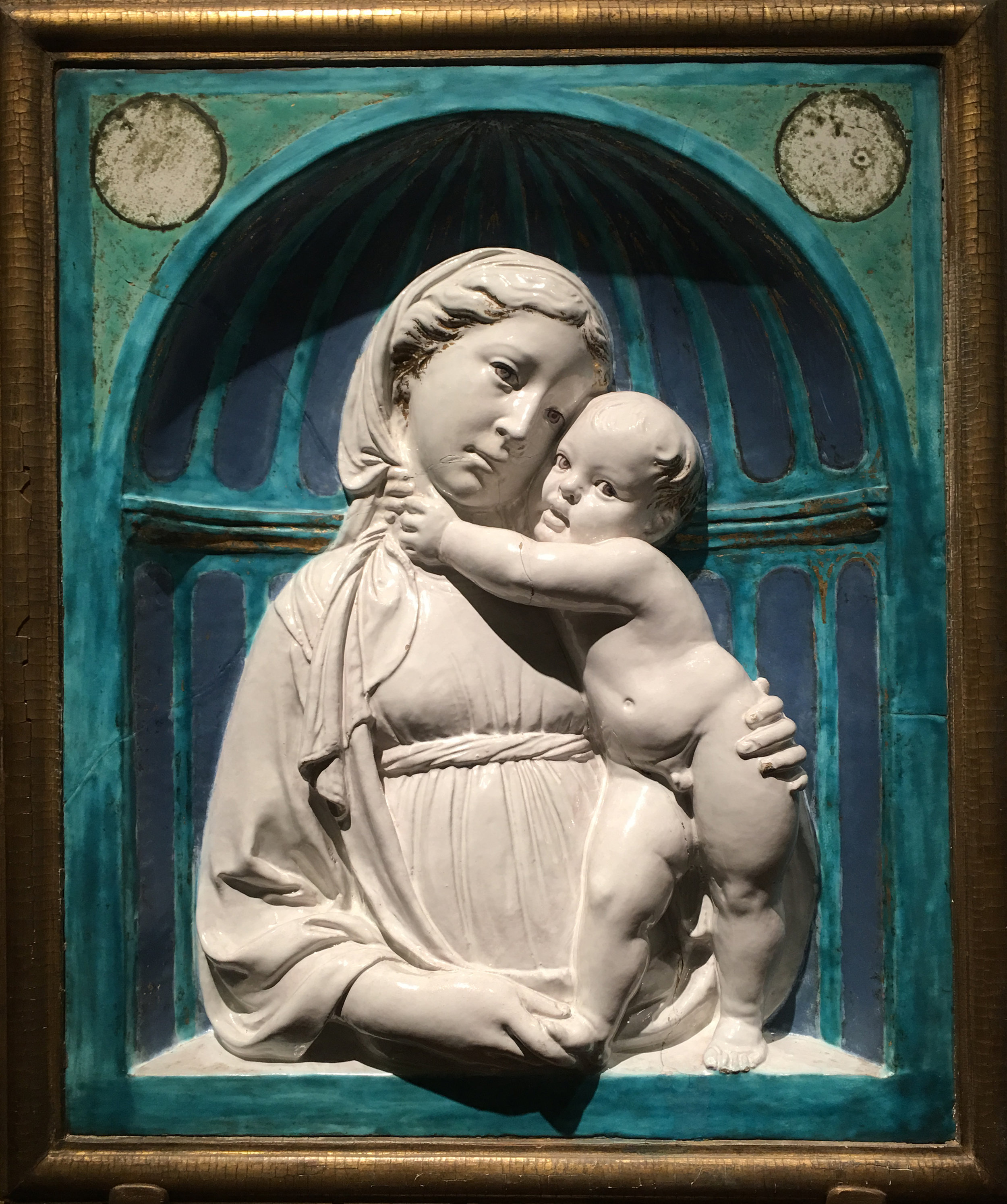In virtually every major museum to which I go, there seem to be distinctive, gloriously lustrous milky white and polychrome glazed terracotta sculptures, tondos, architectural elements, free-standing sculptures, in colours that sing in clarity. I have always loved them for their elegance and harmony, distinctive look and also for their wonderful durability, for these glazed terracotta pieces, big and small, all date from the Renaissance, and were created by three generations in their Florence workshop.
Meet the della Robbias: Luca, uncle, sculptor and founder of the terracotta workshop who lived from 1399/1400 to 1482. His nephew, collaborator and heir, Andrea, lived from 1435 to 1525. Andrea’s sons, especially Giovanni, (1469–1529), collaborated with Andrea and eventually inherited his workshop, taking the polychrome terracotta creations to new heights and frequently signing the pieces, something his forebears had not done (perhaps because of increasing competition).
On a recent visit to Boston, I saw a lot of the della Robbia family’s creations, and they made me go back and think of earlier ones I had seen. The first that I saw was in Boston’s Museum of Fine Arts,
Virgin and Child, glazed terracotta, c. 1448, Luca della Robbia (photograph J. Cook)
From the earliest work that Luca did in glazed terracotta (as opposed to his highly-regarded sculpting in marble), he frequently used moulds for the work, which would have brought down the price. Only the very special, costly pieces were done entirely by hand, in every della Robbia workshop. Believed to be the earliest form of sculpting, terracotta pieces have always been created in clay, fired to considerable hardness. The della Robbias used the finest light-coloured, chalky river clay available, and refined it to a very high grade of clay; this care ensured that the lead tin glazes that were used for the colouring processes would bind well to the clay when fired. This ensured a particular luminosity and shine, a hallmark of this work, especially in the creamy whites.
The Visitation (c. 1445), Luca della Robbia. (Image courtesy of Museum of Fine Arts, Boston)
Luca pioneered the group sculptures that became so sought after for churches, public buildings and even for private homes. Soon Andrea was collaborating with him on such work. Many of the pieces were fired in parts to fit more easily in the kiln and then fitted together according to requirements. This was apparently the case with this Nativity below.
Nativity with Gloria in Excelsis, glazed terracotta, c. 1470, Luca della Robbia, Fine Arts Museum, Boston (photograph J. Cook)
The tondos, or round wall pieces or ceilings, have always been the terracotta sculptures which have impressed me. I loved one that I saw last year in Lisbon at the Gulbenkian, although there are many more in a large collection of della Robbia pieces in the Lisbon Arte Antiga Museum’s Renaissance rooms.
Faith, glazed terracotta, c. 1465-70, Andrea della Robbia, (Image courtesy of Calouste Gulbenkian Museum, Lisbon)
Prudence, c. 1475, glazed terracotta, Andrea della Robbia (Image courtesy of Metropolitan Museum, New York)
All the della Robbia family seemed able to sculpture features and other details in exquisite fashion, no matter to what scale. Even when there is just a fragment, it is still impressive, as in this small head I saw in Boston at the Fine Arts Museum.
Head of the Virgin, glazed terracotta, c. 1490-1500, attributed to Andrea della Robbia (photograph J. Cook)
Seldom does anyone mention the drawings that must have been necessary to plan out all the complex terracotta sculptures, let alone the paintings that would have been the guides to the polychrome glazes that were then applied. But there must have been wonderful backup draughtsmen - or the della Robbias themselves.
Giovanni, in the third generation, frequently created ever more complex pieces, it seems.
Resurrection of Christ (c. 1520–24), Giovanni della Robbia. Brooklyn Museum, New York
The Lamentation of Christ, 1515, glazed terracotta, Giovanni della Robbia, Isabella Gardner Stewart Museum, Boston (photograph J. Cook)
Judith, c. 1520, glazed terracotta, Giovanni della Robbia, Museum of Fine Arts, Boston (photograph J. Cook)
Judith would have been created in a spirit of civic pride in a woman’s virtue, according to the Renaissance optic in Florence. In the same way, the use of humble clay and glazes that created such luminous surfaces was a perfect way to express spiritual humility for the faithful in Christian Florence and beyond. The skill with which the della Robbias fashioned their images and their choice of clear, radiant colours - brilliant opaque whites, deep cerulean blues, and botanical greens, purples and yellows - helped convey messages of faith and salvation in a medium that was both robust and adaptable to many places and uses. Later, Andrea and his sons, especially Giovanni, extended the range of their terracotta creations to portraiture, still life, landscape, and allegory. The family output of work over the three generations must have been prodigious as even today, despite so many wars, earthquakes, fires and other disasters, we are the heirs to many wonderful pieces of their work in glazed terracotta..
No wonder Luca’s younger contemporary Leonardo da Vinci praised these glazes, seeing the method as a way for painting to achieve the permanence of sculpture. As so often, da Vinci was clear-sighted in his assessment.








